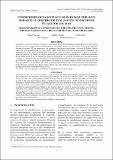Por favor, use este identificador para citar o enlazar este ítem:
https://hdl.handle.net/20.500.12958/7536Registro completo de metadatos
| Campo DC | Valor | Lengua/Idioma |
|---|---|---|
| dc.contributor.author | Quispe, Daniel | - |
| dc.contributor.author | García, Walter | - |
| dc.contributor.author | Diaz, Kevin | - |
| dc.contributor.author | Vásquez, Luis | - |
| dc.contributor.author | Gutiérrez, Dimitri | - |
| dc.date.accessioned | 2023-04-24T20:17:19Z | - |
| dc.date.available | 2023-04-24T20:17:19Z | - |
| dc.date.issued | 2023-03 | - |
| dc.identifier.citation | Quispe, D., García, W., Diaz, K., Vásquez, L. y Gutiérrez D. (2023). Condiciones oceanográficas en el mar peruano durante el crucero de evaluación de recursos pelágicos 2021 02-04. Inf Inst Mar Perú, 50(1), 5-18. | es_ES |
| dc.identifier.issn | 0378-7702 | - |
| dc.identifier.uri | https://hdl.handle.net/20.500.12958/7536 | - |
| dc.description.abstract | El mar peruano durante el verano 2021 se caracterizó por presentar condiciones frías frente a la zona de Talara a Paita, hasta 150 m de profundidad, así como desde Callao hasta Pisco. Frente a la costa central (Chimbote), la aproximación de las Aguas Subtropicales Superficiales (ASS) en la capa somera de 40 m, generó anomalías térmicas positivas. En cambio, el rango de salinidad observado indicó predominio de condiciones normales desde Talara hacia el sur. Se detectó un efecto restringido de las aguas de procedencia ecuatorial en áreas cercanas a la costa al norte de Punta Sal. El oxígeno disuelto mostró mayores concentraciones, en el norte por efecto del aporte de aguas de procedencia ecuatorial, y en zonas oceánicas frente a la costa central de Perú por influencia de las ASS. El efecto del proceso de afloramiento estuvo atenuado en el norte desde Paita hasta Chicama, mientras que, desde Callao a Pisco, esta actividad fue más intensa proyectando isotermas e isoxígenas en forma ascendente hacia la costa. | es_ES |
| dc.description.abstract | ABSTRACT: During the summer of 2021, the oceanographic conditions in the Peruvian sea were distinct. The Talara to Paita zone, as well as the area from Callao to Pisco, exhibited cold conditions up to a depth of 150 m. Conversely, the Subtropical Surface Waters (SSW) generated positive thermal anomalies in the shallow layer of 40 meters along the central coast, particularly in Chimbote. The observed range of salinity indicated that normal conditions predominated from Talara to the south, while the effect of equatorial waters was limited in nearshore areas north of Punta Sal. Higher dissolved oxygen concentrations were observed in the north, where equatorial waters occurred, and in oceanic areas off the central Peruvian coast, due to the influence of the SSW. The upwelling process, a crucial factor for marine productivity in the region, was less intense in the north, from Paita to Chicama, but more pronounced from Callao to Pisco, projecting upward isotherms and isoxygens towards the coast. | - |
| dc.language | spa | - |
| dc.language.iso | spa | es_ES |
| dc.publisher | Instituto del Mar del Perú | es_ES |
| dc.relation.ispartofseries | Informe IMARPE 50(1), 2023; | - |
| dc.rights | info:eu-repo/semantics/openAccess | es_ES |
| dc.rights.uri | https://creativecommons.org/licenses/by/4.0/ | es_ES |
| dc.source | Instituto del Mar del Perú - IMARPE | es_ES |
| dc.source.uri | Repositorio Digital IMARPE | es_ES |
| dc.subject | Mar peruano | es_ES |
| dc.subject | Condiciones oceanográficas | es_ES |
| dc.subject | Masas de agua | es_ES |
| dc.title | Condiciones oceanográficas en el mar peruano durante el crucero de evaluación de recursos pelágicos 2021 02-04 | es_ES |
| dc.title.alternative | Oceanographic conditions in the Peruvian Sea during the 02-04 assessment cruise for pelagic resources (2021) | es_ES |
| dc.type | info:eu-repo/semantics/article | es_ES |
| dc.publisher.country | Perú - Callao | es_ES |
| dc.subject.ocde | http://purl.org/pe-repo/ocde/ford#1.05.11 | es_ES |
| Aparece en las colecciones: | Informe vol. 50(1) 2023 | |
Ficheros en este ítem:
| Fichero | Descripción | Tamaño | Formato | |
|---|---|---|---|---|
| Informe 50-1 articulo 1.pdf | 1 MB | Adobe PDF |  Visualizar/Abrir |
Este ítem está sujeto a una licencia Creative Commons Licencia Creative Commons

